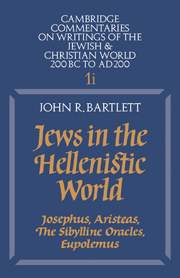THE SIBYLLINE ORACLES
Published online by Cambridge University Press: 08 January 2010
Summary
Origins
The collection of Jewish and Christian writings known as the ‘Sibylline Oracles’ came into being between the second century bc and the fourth century ad. There are allusions and references to this material in Josephus (Ant. I.4.3 (118)), the Shepherd of Hermas, Clement of Rome, Justin Martyr, Clement of Alexandria (who says that Paul used the Sibyl), Lactantius (who quoted many lines from the Sibylline Oracles), and Augustine. The oracles seem to have been popular; the secondcentury anti-Christian intellectual Celsus complained that the Church invented false oracles, and the third-century satirist Lucian parodied them. The collection was eventually numbered in fifteen books, perhaps by the fourth century ad, though there are no surviving manuscripts earlier than the fourteenth century, from which period comes also the famous hymn used in the Mass for the Dead, the ‘Dies Irae’, the opening verse of which quotes the Sibyl alongside scripture as an authority for the coming doom:
Day of wrath and doom impending,
David's word with Sibyl's blending,
Heaven and earth in ashes ending.
(trans, by T. W. Irons, English Hymnal, no. 351)‘Sibyls’, or inspired prophetesses, were well known in the Graeco-Roman world and had a long history. The first-century bc Roman poet Virgil announced in his Fourth Eclogue (40 bc) that the last age prophesied by the Sibyl at Cumae on the Italian coast near Naples had arrived. (See Map 6.)
- Type
- Chapter
- Information
- Jews in the Hellenistic WorldJosephus, Aristeas, The Sibylline Oracles, Eupolemus, pp. 35 - 55Publisher: Cambridge University PressPrint publication year: 1985



